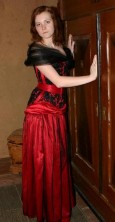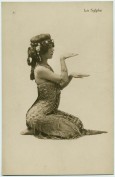Around the turn of the 20th century, a new silhouette of fashion arose with a dedicated small waist-line, which influenced strongly the established style of the "Straight-Front-Corset" and created an improved new corset-style named "S-Line". The women of that time realized increasingly that with this new style it got possible to lace their waist tighter than ever before – the ratio of waist/hip-spring became more prominent. The following improvement to the "Empire-Corset-Style" was the next and final stage in development of corsets, which was made specifically for an extra small silhouette - extra small waist and small hips. The corset-designer offered this style for "Straight-Front-Corsets" as well as for "S-Line-Corsets". The focus of this style was on extra small hips.
Here I like to add, that both styles of corsets as well as the last "Empire"-style marked the heyday of corset wearing of (mostly female-) members of all classes and finalized all further development at the same time. By all means it is easily understandable that in the corset-design of those days all high-end summaries of former periods got seamless integrated into the manufacturing Know-how and offered at reasonable prices to the wearers.
For each corset-designer it is nowadays a challenge, sometimes a kind of provocation, to get familiar with the Know-how of those old corset-designs. This is the only way to redesign the styles with today's available technique, Know-how and material and to continue their development for a modern corset, which is comfortable in wearing, fulfilling today's expectations and manufacturable in different variations.
 |
 |
Picture left: Edith la Sylphe, wearing the corset named Sylphide (appr. 1900).
Source: "Eine Geschichte der Reizwäsche" (A Story of Sexy Underwear),
written by Gilles Néres, Page 88 – Keyword: Extraordinary Posture *)
Picture right: Modern design in cooperation with Nu-Nu-comp.
[For picture-enlargements click into the thumbnails
*) Remarks
With a comparing analysis of the pattern-design versus satisfaction of comfortable wearing of such type of corsets, I detected some findings, which may help to unmask different misunderstandings and to correct them accordingly. Such misunderstandings established themselves via internet or other publications by multiple repeated unproved individual meanings and followed by wrong, unacceptable conclusions.
Misunderstanding N° 1 :
A S-Line-Corset has the need for extra rigid and specifically formed bones
To create a certain shape of the silhouette it is definitively not necessary to implement extra rigid and specifically formed steel-bones into the corset. Analysing historical and original corsets of the investigated period it is easily detectible that designer of those old days used light weighted and very thin pieces of whalebone only and very weak front fastenings without a stiff planchette underneath. They created the expected silhouette by the design and adequate cutting-layout only. Nowadays we are able to demonstrate similar technical characteristic properties of the outdated whalebone by flat spiral-springs – but unfortunately, they are incomparable in their weight.
With the Know-how of the best corset cutting-layout – independent from the designed corset-style "Straight-Front", "S-Line" or the Victorian-Style – an equilibrium of lacing-forces at every point of the body can be achieved. A corset-wearer, who wear her/his corset routinely on a daily basis, gets easily aware, if this principle is fulfilled or not. If it is, she/he accepts the corset as a very comfortable one.
Each corset-style has its own and very specific lay-out of the length, the position and direction of the different stiffeners, which does not allow any change or modification by someone's personal mood or desire. Where and how they are integrated into the corset that is an essential part of the design, strictly aligned to the expected style.
 |
Each corset-style has its own and very specific lay-out of the length, the position and direction of the different stiffeners, which does not allow any change or modification by someone's personal mood or desire. Where and how they are integrated into the corset that is an essential part of the design, strictly aligned to the expected style. |
Picture (left to right) [For enlargement click into picture]
Straight-Front-Corset approx. 1898, S-Line-Corset approx. 1902, S-Line-Corset Specialité (Front- and Side-view) approx. 1908
The today implemented stiff planchettes are generally a certain modification for modern corsets only to support wearing comfort and security against damages. At the lower end, it is more or less bended according to the design and cutting-layout – following the human anatomy – to keep the stomach at its natural place and to prevent any wrinkles of the skin in this front area. The level of bending of the planchette is to be done according to the style of expected corset-design und individual natural body-shape. There are no doubts about the fact, the tighter the waist is laced, the lacing-forces increases, and therefore the importance of best adjustment of the bended planchette increases dramatically.
Both extra stiff rods at the right and left side of the rear lacing-border are a technical necessity to distribute all lacing-forces equal along the length of the border from the lower-edge up to the top-edge of the corset. With such a small technical trick, it is possible to get and to keep the gap between both sides of the corset along the total length constant, which is an additional important subject of wearing-comfort. The implementation of flat spring-bones at other places of the corset is independent from the use of the stiff rods at the lacing-border.
Sometimes, special corsets can be seen, which are designed for extra tightness and stiffness. Here, not only the stiff rods alongside of the row of lacing-eyelets at the rear-side, but also all other corset-stiffeners are made of extra stiff material, mostly of flat steel-bones. Such corsets are specifically designed for "Tightlacer", which are a small minority of all the corset-enthusiasts. One single member of this minority creates much more sensation in public, than the majority of "normal" corset-wearers.
Such a person has its own personal objective, to shape their/his body into a most ideal form and preserve it for a long time. For such aTightlacer, wearing-comfort is of lower importance versus the shaping result of his/her body; comfort is a "want", not a "must". Very often, the implemented "stiffeners" are adjusted in length, form, thickness/stiffness, and/or position according to the individual needs or wishes.
Misunderstanding N° 2 : An S-Line-Corset is uncomfortable
An S-Line-Corset is designed generally for a tight fit, stiff and straight posture. It creates a certain pressure onto the rear side of the torso, which forces the wearer to keep her/his body all times really straight upwards. If the corset is adjusted correctly to the individual wearer, the gap between both corset-edges at the rear lacing- -borderline is a very constant one of approx. 2 cm [approx. 4/5 inch]. The parallel edges indicate that the lacing-forces are distributed equally all over the corset-length. Therefore, the corset can be worn for a long time with best comfort. Additionally, a lacing-protector, implemented underneath the lacing-borderline, distributes also the pressure onto the body, created by the lacing-forces, from a "point" to an "area", which improves the comfort of wearing a second time.
In case of a non-parallel or increased lacing-gap (>2 cm) at the rear of the corset, insufficient distribution of the lacing-forces are indicated. Long-term-wearing of such an insufficient designed and/or adjusted corset will lead mostly to a lot of problems and decreased wearing comfort. The rods for distribution of the lacing-forces right and left side of the lacing-eyelets-borderline can twist and may press their edges onto the kidneys, which can be very painful. So the designer and later on the individual wearer should take care to get and to keep the lacing-gap all time correctly in parallel.
There is no doubt about that the designer and the manufacturer should be all times aware on the above mentioned problems and difficulties. They are an important object concerning not only the S-Line-Style but all other corset-styles also.
Misunderstanding N° 3 :
An S-Line-Corset forces the wearer to an extraordinary, unnatural posture
 |
 |
 |
Picture:
A S-line-corset, worn by a young Lady, at different postures: Sitting and standing [For enlargement please click into picture]
Is this statement true or false? The correct answer can be right as well as wrong at the same time – it depends on the observer's expectation.
To find the right answer for yourself, please, have a look onto the picture of the corset "Sylphide", shown on top of this page. The corset forces the extraordinary and unnatural posture of Lady Edith la Sylphe, which is for an observer of today very inacceptable. The picture (right of Sylphide) and the above 3 pictures demonstrates a moderate and nice, upright posture. Nevertheless, both corset-types follow the same principle of so-called "Posture-Corsets", but they create very different postures of the wearer.
Depending on the individual flexibility on the body of the corset-wearer and depending on the design of the corset, both types of posture can be achieved: an pronounced posture by an enforced bended rear side as well as an extreme upright posture. For both types of posture, the individual human basic conditions are indispensable. It is impossible to achieve necessary human conditions by the corset-design.
Is the wearer's rear-side more or less enforced to get bended, the corset activates certain muscles at the lower end of the torso. They are active all time and kept under a certain stress – quite independent, the wearer take a seat or is walking. Generally, it is known that, having a seat for a longer period, the wearer feels less comfortable versus standing or walking for the same time. The reason is, each individual person has its own quite personal "Limit of tolerance of convenience", which indicates at one side comfortableness and embarrassment at the other. According to our knowledge, the length of the corset down to the thighs sets the limit: the longer it is, the limit is pushed more in direction of embarrassment. If the lower corset-edge is designed to reach the knees, it is definitely impossible to take a seat.
Additionally, the corset-wearer has to have all time in her/his mind that with the initially defined posture and designed cutting-layout of the corset, the chosen posture is fixed – independent from walking or sitting of the person. This statement is valid for the S-Line-Style not only, but for other styles like Straight-Front-Style or Victorian-Style also.
© Copyright Sabine Zieseniss





